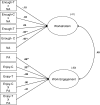To stop or not to stop, that's the question: about persistence and mood of workaholics and work engaged employees
- PMID: 21373772
- PMCID: PMC3212689
- DOI: 10.1007/s12529-011-9143-z
To stop or not to stop, that's the question: about persistence and mood of workaholics and work engaged employees
Abstract
Background: Although workaholics and work engaged employees both work long hours, they seem to have a different underlying motivation to do so. The mood as input model might offer an explanation for the difference in work persistence of these employees. This model suggests that the interplay of mood and "persistence rules" (enough and enjoyment rules) may lead to different kinds of persistence mechanisms.
Purpose: The aims of this study are to present a scale for measuring persistence rules, the Work Persistence rules Checklist (WoPeC), to analyze its psychometric properties and to test the mood as input model in relationship with workaholism and work engagement.
Method: Structural equation modeling was used to analyze the data.
Results: Results of a confirmatory factor analysis in study 1 provided support for the hypothesized factor structure of the WoPeC. In study 2, it appeared that the use of an enough and an enjoyment rule for determining when to continue working is related to workaholism and work engagement, respectively. Furthermore, it was hypothesized and found that negative mood is related to workaholism, whereas positive mood is associated with work engagement. The expected interactions between mood and persistence rules on workaholism and work engagement were not demonstrated.
Conclusion: Mood and persistence rules seem relevant for explaining the difference between workaholism and work engagement.
Figures


Similar articles
-
Are Engaged Workaholics Protected against Job-Related Negative Affect and Anxiety before Sleep? A Study of the Moderating Role of Gender.Int J Environ Res Public Health. 2018 Sep 13;15(9):1996. doi: 10.3390/ijerph15091996. Int J Environ Res Public Health. 2018. PMID: 30217032 Free PMC article.
-
Workaholic and work engaged employees: dead ringers or worlds apart?J Occup Health Psychol. 2011 Oct;16(4):468-82. doi: 10.1037/a0024392. J Occup Health Psychol. 2011. PMID: 21787085
-
Job autonomy in relation to work engagement and workaholism: Mediation of autonomous and controlled work motivation.Int J Occup Med Environ Health. 2018 Jul 4;31(4):445-458. doi: 10.13075/ijomeh.1896.01197. Epub 2018 Feb 7. Int J Occup Med Environ Health. 2018. PMID: 29410554
-
[Workaholism: between illusion and addiction].Encephale. 2010 Sep;36(4):285-93. doi: 10.1016/j.encep.2009.12.002. Epub 2010 Mar 10. Encephale. 2010. PMID: 20850599 Review. French.
-
[Workaholism - indications for diagnosis and review of interventions].Med Pr. 2015;66(1):71-83. Med Pr. 2015. PMID: 26016047 Review. Polish.
Cited by
-
Are Engaged Workaholics Protected against Job-Related Negative Affect and Anxiety before Sleep? A Study of the Moderating Role of Gender.Int J Environ Res Public Health. 2018 Sep 13;15(9):1996. doi: 10.3390/ijerph15091996. Int J Environ Res Public Health. 2018. PMID: 30217032 Free PMC article.
-
The Firepower of Work Craving: When Self-Control Is Burning under the Rubble of Self-Regulation.PLoS One. 2017 Jan 9;12(1):e0169729. doi: 10.1371/journal.pone.0169729. eCollection 2017. PLoS One. 2017. PMID: 28068379 Free PMC article.
-
Occupational health--items on the research agenda.Int J Behav Med. 2011 Dec;18(4):293-4. doi: 10.1007/s12529-011-9199-9. Int J Behav Med. 2011. PMID: 22012489 No abstract available.
-
Workaholism and sleep quality among Japanese employees: a prospective cohort study.Int J Behav Med. 2014 Feb;21(1):66-76. doi: 10.1007/s12529-012-9286-6. Int J Behav Med. 2014. PMID: 23242836
-
Effect of role overload on missed nursing care in China: The role of work addiction and leader-member exchange.Nurs Open. 2023 May;10(5):3153-3163. doi: 10.1002/nop2.1565. Epub 2022 Dec 23. Nurs Open. 2023. PMID: 36564925 Free PMC article.
References
-
- Sullivan C. What’s in a name? Definitions and conceptualisations of teleworking and homeworking. New Technol Work Employ. 2006;18(3):158–165. doi: 10.1111/1468-005X.00118. - DOI
-
- Forlano L. Working on the move: the social and digital ecologies of mobile work places. In: Hislop D, editor. Mobility and technology in the workplace. London: Routledge; 2007.
-
- Cascio W. Strategies for responsible restructuring. Acad Manage Exec. 2002;16(3):80–91. doi: 10.5465/AME.2002.8540331. - DOI
-
- Galinsky E, Kim SS, Bond JT. Feeling overworked? When work becomes too much. New York: Families and Work Institute; 2001.
Publication types
MeSH terms
LinkOut - more resources
Full Text Sources

